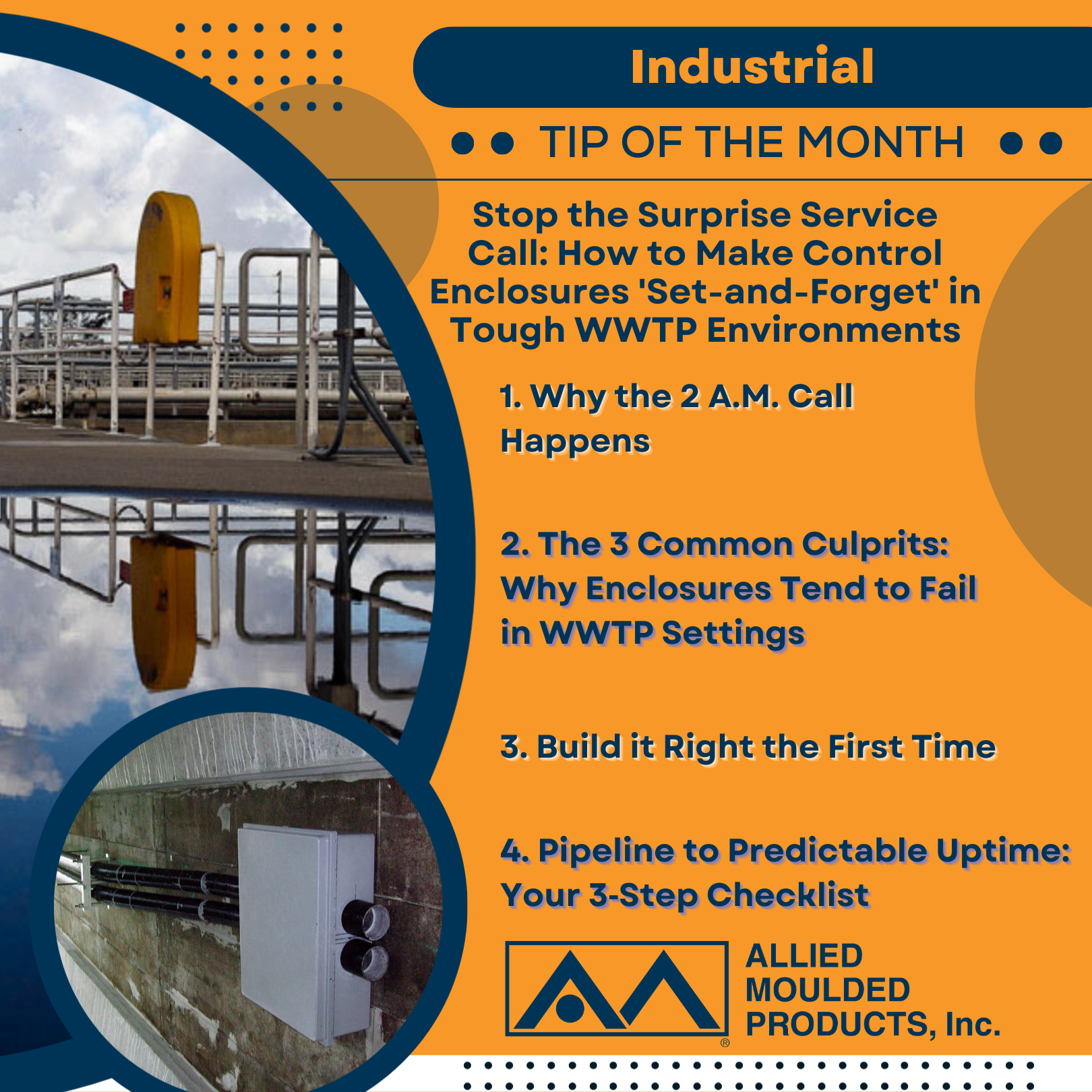
“Good maintenance” alone won’t keep wastewater treatment plant (WWTP) control enclosures running without those dreaded middle-of-the-night service calls. But with a smarter design, more effective inspections, and materials that actually hold up to the job, you can greatly reduce those costly disruptions.
If you’re looking to improve uptime and make your maintenance costs more predictable, here are a few things to think about.
Why the 2 A.M. Call Happens
Unexpected failures in control enclosures usually trace back to three big issues: moisture, temperature, and contamination.
Moisture sneaks in through weak gaskets or poor knockout seals. Fluctuating temperatures stress components and often cause condensation. Dust, biofilm, or even insects get inside and instigate electrical faults.
In the WWTP environment, you’re dealing with all three — on a daily basis.
The 3 Common Culprits: Why Enclosures Tend to Fail in WWTP Settings
1. Moisture & Corrosion
Humidity, condensation, and chemical vapor can corrode internal components and degrade seals, especially around knockouts.
2. Temperature Swings
WWTP control rooms or outdoor enclosures may see extreme swings: hot on sunny days, chilly at night. Internal heat from drives or transformers makes it worse.
3. Dust, Biofilm & Pest Intrusion
Debris, aerosols, and insects can find their way into poorly‑sealed enclosures, leading to shorts, insulation breakdown, or shorted terminals.
Material Matters
Choose enclosures rated for real‑world WWTP abuse — not just indoor dry labs. Here’s what to focus on:
- IP66 / NEMA 4X rating: Guards against high-pressure wash downs, corrosion, and fine particulates.
- Fiberglass-reinforced polyester: Good for outdoor UV exposure and corrosion resistance.
- Polycarbonate (like AMP Series): Offers translucent visibility, impact resistance, and inherent UV stability.
- Custom modified knockouts and gaskets: We cut holes with a router machine to give customers a clean edge hole, avoiding knife‑cut imperfections that later leak.
If your enclosure doesn’t hold up, nothing inside it will either.
Real Examples: Our AM Series and AMP Series deliver factory-customized, clean-cut knockouts and gasket integrity designed for corrosive, wet, and abrasive environments — all with US‑made quality that resists counterfeit shortcuts. These enclosures also support smoother AHJ inspections and reduce risk of code violations by maintaining seal integrity in high-moisture zones, making them an ideal choice for WWTP contractors aiming for long-term reliability with fewer service disruptions.
Build it Right the First Time
How you install your enclosure has just as much impact as what you install. Uneven torque on cover screws can compromise gasket seals. Caulk-only sealing around conduit entries is a recipe for leaks. And don’t forget orientation — drip skirts belong on top, not wherever the installer found room.
Inside the enclosure, lay out components to minimize heat build-up. Keep wiring bundles tight and away from potential condensate pools. Use blank panels or partitions to help guide airflow if fans are needed.
Venting is another critical (but often overlooked) detail. In high-humidity settings, a pressure-equalizing valve or membrane vent can release internal pressure without letting moisture in. And for enclosures with batteries or dense electronics, a desiccant pack is cheap insurance.
Routine That Pays Off
Regular, quick checks across each quarter or semester can prevent most failures:
| Check | Description | Why It Matters |
|---|---|---|
| Gasket Integrity | Inspect all gaskets for cracks, compression set, or drying out. | A faulty seal lets in moisture fast. |
| Knockout Caps* | Verify unused knockouts are fully plugged and sealed. | Loose plugs are common ingress points. |
| Interior Dryness | Check for condensation or wetness inside, especially on metal parts or junctions. Rate dryness with a desiccant card or micro‑paper. | Indoor condensation often precedes corrosion. |
| Dust & Debris | Wipe any dust off wires or components. Look under terminal blocks. | Fine particulate can be conductive or flammable. |
| Label/Marker Legibility | Ensure wiring labels remain legible and protective sleeves haven’t cracked. | Helps when quick servicing is needed. |
These simple habits can drastically reduce the chances of an emergency call.
*View our enclosure accessories and patented hole plugs.
Pipeline to Predictable Uptime: Your 3‑Step Checklist
- Build It Right: Specify IP66 / NEMA 4X enclosures with factory-customized, clean-cut knockouts, corrosion‑resistant material, and correctly sized vents.
- Inspect Smart, Inspect Often: Monthly visual checks for seal integrity, moisture, and debris. Quarterly desiccant and gasket checks.
- Act Early: Replace worn gaskets, seal unused knockouts, or corroded fixtures quickly, before they fail.
Reliable control enclosures are built on choosing the right one, installing it properly, and checking in regularly. If you want to reduce maintenance surprises and get ahead of the next failure, start there.
For WWTP operators and contractors, the right enclosure can be the difference between smooth sailing and a surprise 2 a.m. call. Our AM Series and AMP Series offer the kind of rugged reliability and thoughtful design that help your team build smarter from the start.
Want true ‘set-and-forget’ performance? It starts with choosing the right enclosure from the start.
